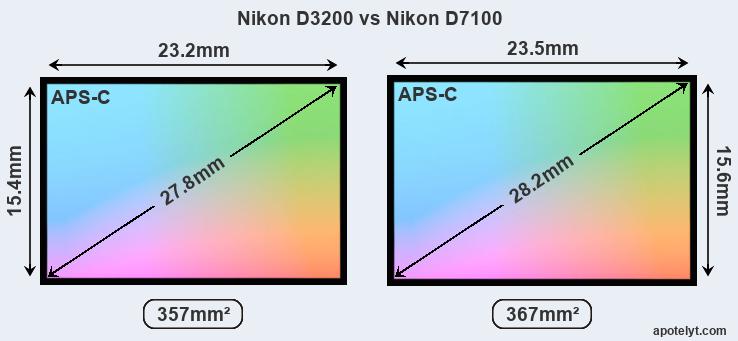

This trick - if it can be called that - cuts out diffusion that said filter would otherwise serve to function and, therefore, images should have improved sharpness straight from camera. The Nikon D7100 is testament to that - it not only employs enough top specs to rival even the well-established D300S from Nikon's own range but, and much like the Nikon D800E, has removed the low-pass filter from its imaging equation. Storage support includes SD, SDHC, and/or SDXC memory cards.(Pocket-lint) - Cameras are evolving. Images can be transferred from both cameras via USB. For GPS capabilities, a different adapter can be purchase for either camera.

The D5100 has no such adapter, so all images must be transferred via USB or memory card. The D3200 has no wi-fi support by default, but an adapter can be purchased to transfer images wirelessly.

Both cameras measure approximately 5.0”W x 3.8”H x 3.1”D. The D3200 weighs 505 grams, and the D5100 weighs 560 grams. The D3200 weighs slightly less than the D5100. Both cameras support "classic" and "graphic" displays and allow users to choose between color themes (black, blue/green/white, brown/orange). The menus are intuitive and easy to navigate. The user interfaces of the D3200 and the D5100 are very similar. The D3200 offers the same six types of picture control, but does not have any image effects or in-camera editing functions.Įxample of one interface theme seen in the D3200's red body. The D5100 has seven image effect modes, including night vision and color selection modes six types of picture control and 19 in-camera editing capabilities. The edges of the two images can be smoothed to create one fluid image. With this feature, the user can create higher contrast photos with more details, less noise, and more vibrant tones. This allows a user to take two multi-exposure images with one shutter release these images are combined to create one picture. The D5100 offers High Dynamic Range (HDR) shooting. The difference is so small that most users will not find it is noticeable. The D5100 has a slightly larger image sensor than the D3200. The larger the image sensor, the more information the camera perceives in creating an image.
#Nikon d3200 vs d7100 how to#
The difference is extreme however, if the user does not know how to balance the larger ISO sensitivity with the shutter speed, the images of the D5100 will not necessarily look better. The D5100 can reach an extended ISO sensitivity of 25600 while the D3200 has a maximum ISO sensitivity of 128000. However, this higher sensitivity can also add grain or noise to an image, making ISO sensitivity a difficult balance for many new photographers. The bigger the ISO sensitivity number, the clearer pictures the camera can take in low light without a flash. ISO sensitivity is the ability of the camera to use the available light for an image. For DSLR cameras, the composition, lighting, and lens make some of the biggest differences in photo quality.Īnother significant difference between the D3200 and the D5100 is the ISO sensitivity. Many beginner photographers assume that more megapixels means the camera takes better pictures, but that is not always the case. The D3200 has a sizable advantage with 24.2 megapixels versus the 16.2 megapixels of the D5100. One of the most significant differences between the D3200 to the D5100 is the resolution, a.k.a., number of megapixels.
#Nikon d3200 vs d7100 manual#
Nikon EN-EL14 rechargeable Lithium-Ion batteryģD Color Matrix Metering II, Center-weighted and SpotĪuto modes (auto, auto ), Guide Mode, Advanced Scene Modes (Portrait, Landscape, Sports, Close-up, Night Portrait), programmed auto with flexible program (P), shutter-priority auto (S), aperture-priority auto (A), manual (M), (Q) quiet modĪuto, advanced scene, shutter-priority auto, aperture-priority auto, manual, quiet mode 455 g (1.00 lb) without battery, memory card or body capĪpproximately 510 g (1 lb. Compatible with the Nikon Creative Lighting System.ģ0 s to 1/4000 s in 1/2 or 1/3 stops and Bulb, 1/200 s X-syncĪpprox. 6,016 × 4,000 (24.2 effective megapixels)Ĥ,928 x 3,264 pixels (16.2 effective megapixels).Ģ3.1 mm × 15.4 mm Nikon DX format RGB CMOS sensor, 1.5 × FOV crop, 3.85µm pixel sizeĢ3.6 mm x 15.6 mm Nikon DX format RGB CMOS sensor, 1.5 × FOV crop.īuilt in Pop-up, Guide number 13m at ISO 100, Standard ISO hotshoe, Compatible with the Nikon Creative Lighting Systemīuilt in Pop-up, Guide number 13m at ISO 100, Standard ISO hotshoe.


 0 kommentar(er)
0 kommentar(er)
